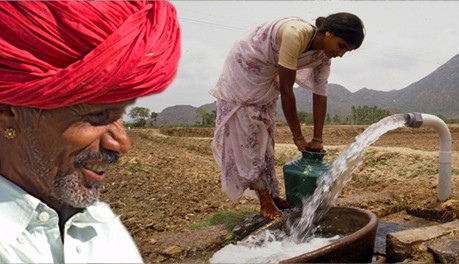Water + Electricity = Reduced Emissions in India

“If we save water, we save energy, too – and vice versa.” That is the motto of the Water-Energy Nexus (WENEXA) program, an innovative public-private partnership in India, supported by USAID, that aims to reduce greenhouse gasses by conserving water and energy which are in dangerously short supply in a nation with a huge and ever-growing population. Demand for these resources is expected to double in the next 25 years. Water and energy are closely linked in the vital agricultural sector, which accounted for more than 17% of GDP and employed more than half of the national workforce in 2010.
Indian agriculture depends heavily on groundwater, which must be extracted with electric pumps. The current situation poses a critical challenge because the notoriously inefficient older pumps waste far too much electricity. Electricity in India is priced significantly below cost due to large subsidies, so farmers tend to over-consume energy for irrigation, which has led to an alarming depletion of groundwater levels. The uncertain availability of power leads farmers to draw more water than they need, compounding the problem.
In Karnataka, the largest Indian state in the south, the looming water crisis is easy to measure and visualize. Karnataka’s water table is unusually deep at 400-700 feet. “After a lot of analysis, it was decided that we needed to intervene in Karnataka’s agriculture sector to effect savings in both water and energy,” says Rakesh Kumar Goyal, chief of party for WENEXA. That dual focus, Mr. Goyal emphasizes, is the most distinguishing and important feature of WENEXA.
In 2004, USAID/India and the Government of India’s Ministry of Power launched WENEXA and contracted with Tetra Tech to determine possible financial models to replace existing pumps.
USAID provided $5.8 million for technical assistance and capacity building for the program. A public-private partnership agreement was signed between the state utility and private energy service company (ESCO) to replace the pumps. The ESCO obtained a loan from the national agricultural bank to replace the existing pumps with new, energy efficient models.
Officials implementing WENEXA enhanced its effectiveness through careful planning, involving many entities. For the initiative to succeed, local farmers had to be willing to embrace pump efficiencies, adopt irrigation technologies, and agroforestry practices. To achieve that goal, a Bangalore-based NGO interacted regularly with the farm community, organizing focus group discussions, training programs, and exposure visits.
To date, more than 500 farmers have been educated about the importance of creating energy/water efficiency and how to realize it. For individual farmers, achievement came principally via new hardware - the energy efficient pumps save electricity. Replacing old pumps has the potential to save 46 percent in electricity consumption.
“This has been a very challenging project, but one of high impact, as well,” says Ms. Apurva Chaturvedi, USAID Program Management Specialist for WENEXA. “The concentrations of resources into a single end-use area make the water-energy nexus an imperative challenge for the future of India. USAID’s WENEXA program has tried to address this complex problem, and we are very pleased with the results.”
USAID/India and the Ministry of Power envision the positive results from WENEXA spreading across the country. The state governments of Karnataka and Maharashtra are very supportive and would like to see the program introduced in their respective states.
“With an investment in the initiative of $13.2 billion,” the joint report from USAID/India and Ministry of Power states, “India could reduce its electricity demand-supply gap by 50% and its annual agricultural tariff by 9 billion rupees [$200 million] a year.” Those savings “can be used for power-sector upgrades in areas where savings are being realized and for other development needs of the states … The multiplier effect of fresh investments will be reflected in employment and income generation.”
The multiplier effect will not be limited to those outcomes. As Goyal points out, “We have already been influencing policy in other Indian states.” The influence goes well beyond policy. As
water and energy are conserved, energy emissions are reduced, allowing the program to positively impact the country’s effect on climate change.
WENEXA, with its USAID backing, has turned a lose-lose situation into a very effective win-win.
R.M. Williams







Comment
Make a general inquiry or suggest an improvement.